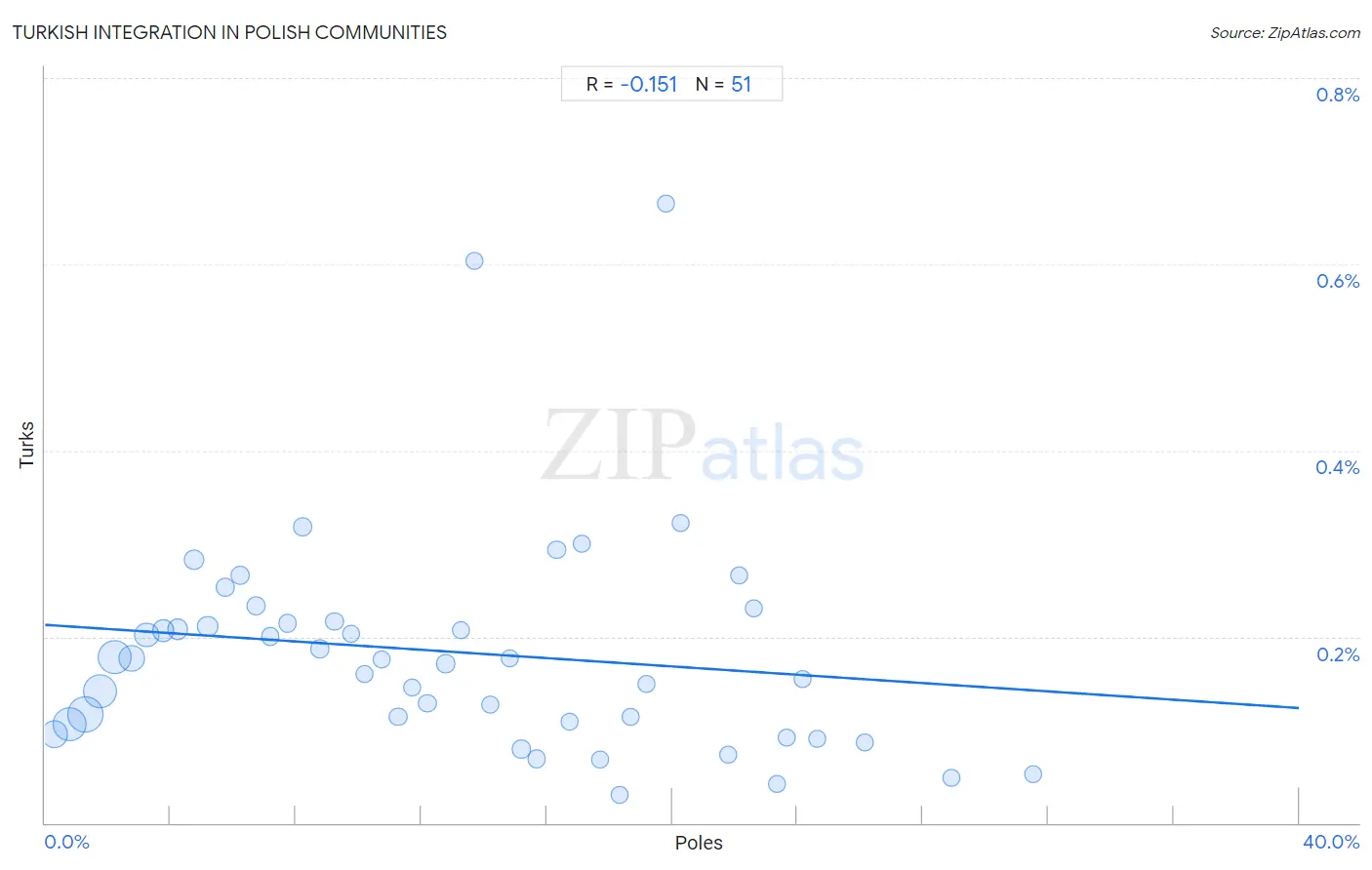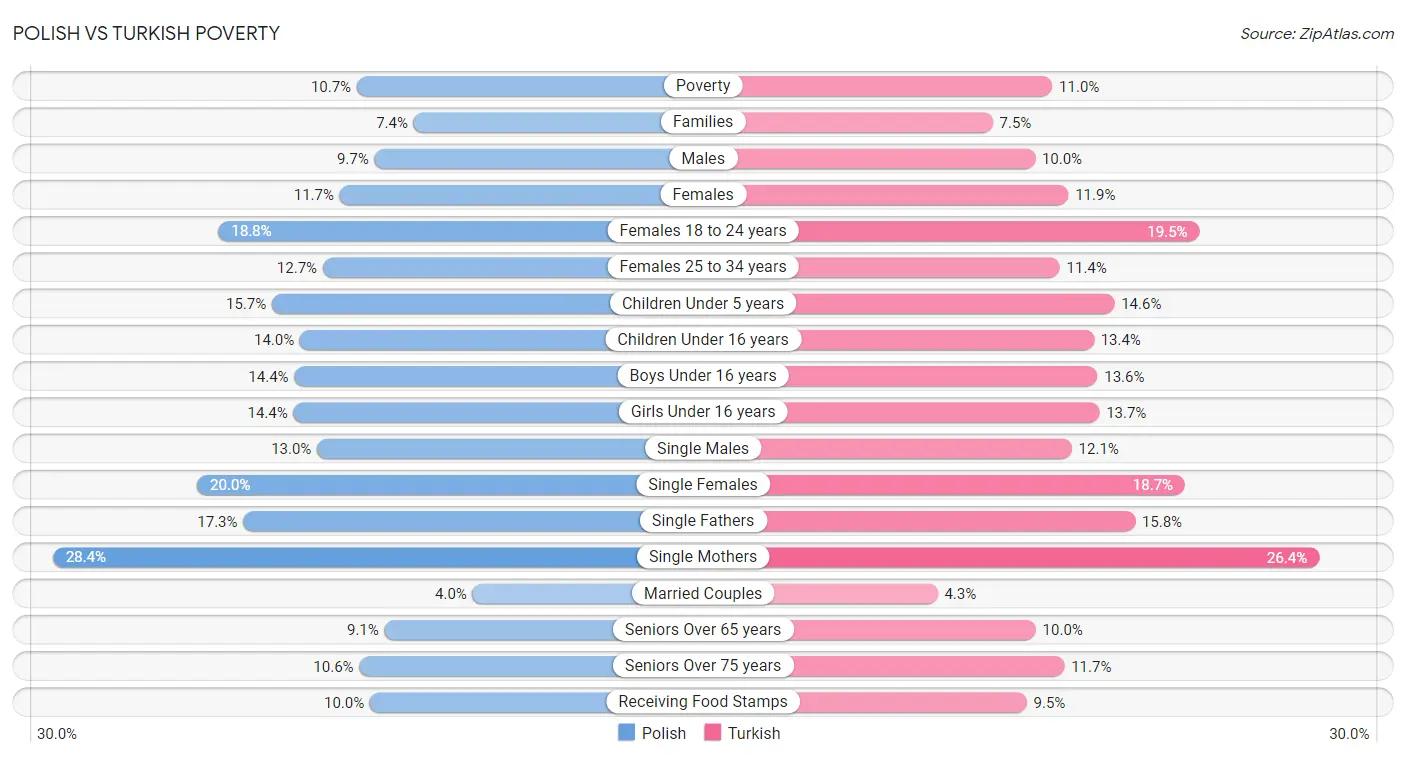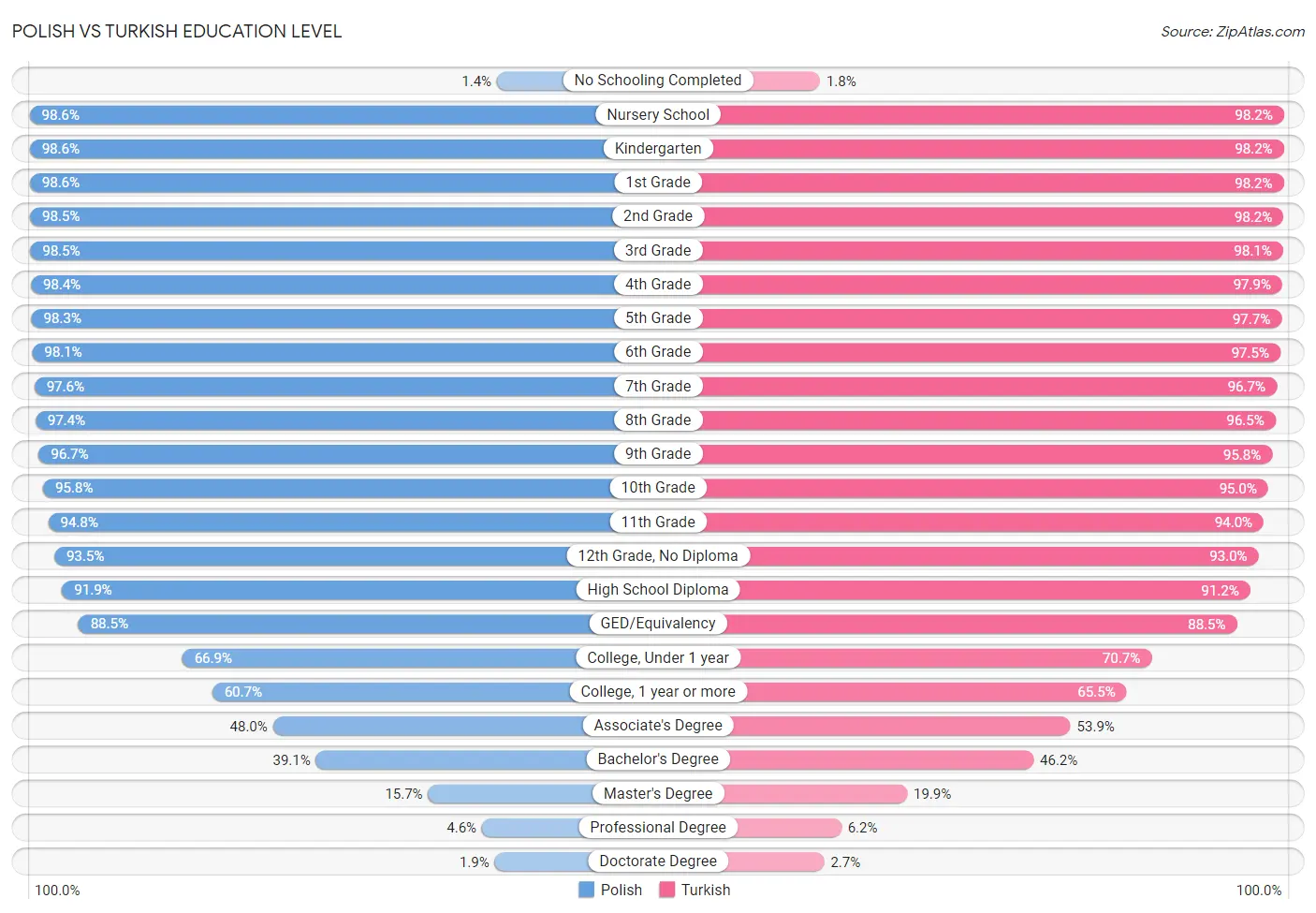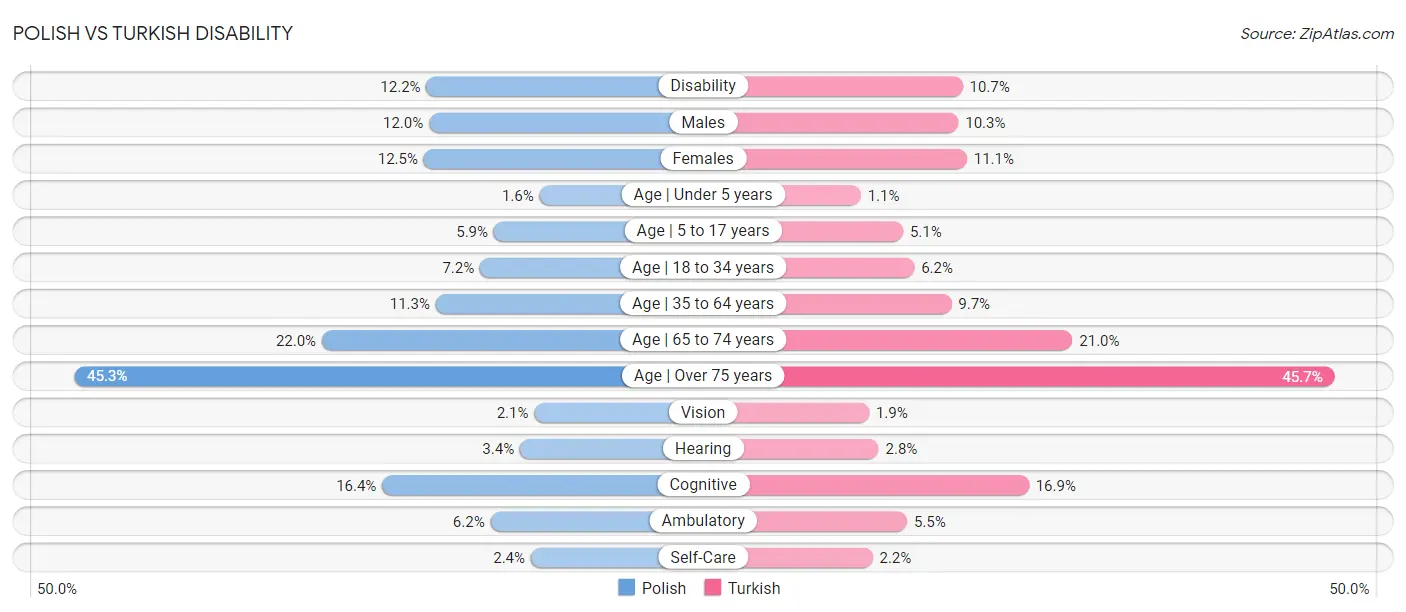Polish vs Turkish Community Comparison
COMPARE
Polish
Turkish
Social Comparison
Social Comparison
Poles
Turks
8,413
SOCIAL INDEX
81.6/ 100
SOCIAL RATING
72nd/ 347
SOCIAL RANK
9,373
SOCIAL INDEX
91.2/ 100
SOCIAL RATING
17th/ 347
SOCIAL RANK
Turkish Integration in Polish Communities
The statistical analysis conducted on geographies consisting of 271,421,297 people shows a poor negative correlation between the proportion of Turks within Polish communities in the United States with a correlation coefficient (R) of -0.151. On average, for every 1% (one percent) increase in Poles within a typical geography, there is a decrease of 0.002% in Turks. To illustrate, in a geography comprising of 100,000 individuals, a rise of 1,000 Poles corresponds to a decrease of 2.2 Turks.

Polish vs Turkish Income
When considering income, the most significant differences between Polish and Turkish communities in the United States are seen in per capita income ($46,123 compared to $52,391, a difference of 13.6%), median household income ($88,472 compared to $99,389, a difference of 12.3%), and median family income ($108,507 compared to $121,202, a difference of 11.7%). Conversely, both communities are more comparable in terms of wage/income gap (28.5% compared to 27.7%, a difference of 3.0%), householder income under 25 years ($52,407 compared to $54,266, a difference of 3.5%), and householder income over 65 years ($61,598 compared to $68,037, a difference of 10.4%).

| Income Metric | Polish | Turkish |
| Per Capita Income | Exceptional $46,123 | Exceptional $52,391 |
| Median Family Income | Exceptional $108,507 | Exceptional $121,202 |
| Median Household Income | Excellent $88,472 | Exceptional $99,389 |
| Median Earnings | Exceptional $48,659 | Exceptional $53,919 |
| Median Male Earnings | Exceptional $58,139 | Exceptional $64,253 |
| Median Female Earnings | Excellent $40,371 | Exceptional $44,695 |
| Householder Age | Under 25 years | Good $52,407 | Exceptional $54,266 |
| Householder Age | 25 - 44 years | Exceptional $99,685 | Exceptional $110,318 |
| Householder Age | 45 - 64 years | Exceptional $105,952 | Exceptional $117,814 |
| Householder Age | Over 65 years | Good $61,598 | Exceptional $68,037 |
| Wage/Income Gap | Tragic 28.5% | Tragic 27.7% |
Polish vs Turkish Poverty
When considering poverty, the most significant differences between Polish and Turkish communities in the United States are seen in female poverty among 25-34 year olds (12.7% compared to 11.4%, a difference of 11.5%), seniors poverty over the age of 75 (10.6% compared to 11.7%, a difference of 10.1%), and single father poverty (17.3% compared to 15.8%, a difference of 9.9%). Conversely, both communities are more comparable in terms of family poverty (7.4% compared to 7.5%, a difference of 0.98%), female poverty (11.7% compared to 11.9%, a difference of 1.4%), and poverty (10.7% compared to 11.0%, a difference of 2.1%).

| Poverty Metric | Polish | Turkish |
| Poverty | Exceptional 10.7% | Exceptional 11.0% |
| Families | Exceptional 7.4% | Exceptional 7.5% |
| Males | Exceptional 9.7% | Exceptional 10.0% |
| Females | Exceptional 11.7% | Exceptional 11.9% |
| Females 18 to 24 years | Exceptional 18.8% | Exceptional 19.5% |
| Females 25 to 34 years | Exceptional 12.7% | Exceptional 11.4% |
| Children Under 5 years | Exceptional 15.7% | Exceptional 14.6% |
| Children Under 16 years | Exceptional 14.0% | Exceptional 13.4% |
| Boys Under 16 years | Exceptional 14.4% | Exceptional 13.6% |
| Girls Under 16 years | Exceptional 14.4% | Exceptional 13.7% |
| Single Males | Poor 13.0% | Exceptional 12.1% |
| Single Females | Exceptional 20.0% | Exceptional 18.7% |
| Single Fathers | Tragic 17.3% | Exceptional 15.8% |
| Single Mothers | Exceptional 28.4% | Exceptional 26.4% |
| Married Couples | Exceptional 4.0% | Exceptional 4.3% |
| Seniors Over 65 years | Exceptional 9.1% | Exceptional 10.0% |
| Seniors Over 75 years | Exceptional 10.6% | Excellent 11.7% |
| Receiving Food Stamps | Exceptional 10.0% | Exceptional 9.5% |
Polish vs Turkish Unemployment
When considering unemployment, the most significant differences between Polish and Turkish communities in the United States are seen in unemployment among seniors over 75 years (10.3% compared to 8.6%, a difference of 19.8%), unemployment among women with children under 6 years (7.9% compared to 7.0%, a difference of 11.6%), and female unemployment (4.7% compared to 5.0%, a difference of 6.1%). Conversely, both communities are more comparable in terms of unemployment among ages 65 to 74 years (5.3% compared to 5.3%, a difference of 0.16%), unemployment among seniors over 65 years (5.1% compared to 5.1%, a difference of 0.26%), and male unemployment (4.9% compared to 5.0%, a difference of 0.47%).

| Unemployment Metric | Polish | Turkish |
| Unemployment | Exceptional 4.7% | Exceptional 4.9% |
| Males | Exceptional 4.9% | Exceptional 5.0% |
| Females | Exceptional 4.7% | Exceptional 5.0% |
| Youth < 25 | Exceptional 11.0% | Excellent 11.4% |
| Age | 16 to 19 years | Exceptional 16.4% | Good 17.3% |
| Age | 20 to 24 years | Exceptional 10.0% | Average 10.3% |
| Age | 25 to 29 years | Good 6.5% | Exceptional 6.2% |
| Age | 30 to 34 years | Good 5.3% | Exceptional 5.1% |
| Age | 35 to 44 years | Exceptional 4.4% | Exceptional 4.3% |
| Age | 45 to 54 years | Exceptional 4.2% | Exceptional 4.3% |
| Age | 55 to 59 years | Exceptional 4.7% | Exceptional 4.7% |
| Age | 60 to 64 years | Exceptional 4.7% | Excellent 4.8% |
| Age | 65 to 74 years | Good 5.3% | Good 5.3% |
| Seniors > 65 | Excellent 5.1% | Excellent 5.1% |
| Seniors > 75 | Tragic 10.3% | Good 8.6% |
| Women w/ Children < 6 | Poor 7.9% | Exceptional 7.0% |
| Women w/ Children 6 to 17 | Tragic 9.4% | Average 8.9% |
| Women w/ Children < 18 | Exceptional 5.0% | Exceptional 5.0% |
Polish vs Turkish Labor Participation
When considering labor participation, the most significant differences between Polish and Turkish communities in the United States are seen in in labor force | age 16-19 (42.1% compared to 35.4%, a difference of 19.0%), in labor force | age 20-24 (77.6% compared to 73.9%, a difference of 5.0%), and in labor force | age > 16 (64.7% compared to 66.1%, a difference of 2.2%). Conversely, both communities are more comparable in terms of in labor force | age 35-44 (85.2% compared to 85.1%, a difference of 0.13%), in labor force | age 25-29 (85.8% compared to 85.6%, a difference of 0.17%), and in labor force | age 30-34 (85.5% compared to 85.7%, a difference of 0.21%).

| Labor Participation Metric | Polish | Turkish |
| In Labor Force | Age > 16 | Tragic 64.7% | Exceptional 66.1% |
| In Labor Force | Age 20-64 | Exceptional 80.1% | Exceptional 80.3% |
| In Labor Force | Age 16-19 | Exceptional 42.1% | Tragic 35.4% |
| In Labor Force | Age 20-24 | Exceptional 77.6% | Tragic 73.9% |
| In Labor Force | Age 25-29 | Exceptional 85.8% | Exceptional 85.6% |
| In Labor Force | Age 30-34 | Exceptional 85.5% | Exceptional 85.7% |
| In Labor Force | Age 35-44 | Exceptional 85.2% | Exceptional 85.1% |
| In Labor Force | Age 45-54 | Exceptional 83.6% | Exceptional 83.8% |
Polish vs Turkish Family Structure
When considering family structure, the most significant differences between Polish and Turkish communities in the United States are seen in births to unmarried women (30.8% compared to 27.4%, a difference of 12.2%), single father households (2.2% compared to 2.0%, a difference of 11.1%), and divorced or separated (11.9% compared to 11.2%, a difference of 6.5%). Conversely, both communities are more comparable in terms of family households (64.0% compared to 63.6%, a difference of 0.54%), married-couple households (48.5% compared to 47.8%, a difference of 1.5%), and single mother households (5.6% compared to 5.5%, a difference of 1.7%).

| Family Structure Metric | Polish | Turkish |
| Family Households | Poor 64.0% | Tragic 63.6% |
| Family Households with Children | Tragic 26.5% | Average 27.4% |
| Married-couple Households | Exceptional 48.5% | Exceptional 47.8% |
| Average Family Size | Tragic 3.09 | Tragic 3.16 |
| Single Father Households | Exceptional 2.2% | Exceptional 2.0% |
| Single Mother Households | Exceptional 5.6% | Exceptional 5.5% |
| Currently Married | Exceptional 48.9% | Exceptional 47.8% |
| Divorced or Separated | Good 11.9% | Exceptional 11.2% |
| Births to Unmarried Women | Good 30.8% | Exceptional 27.4% |
Polish vs Turkish Vehicle Availability
When considering vehicle availability, the most significant differences between Polish and Turkish communities in the United States are seen in no vehicles in household (8.4% compared to 11.7%, a difference of 38.4%), 3 or more vehicles in household (20.2% compared to 18.4%, a difference of 9.6%), and 4 or more vehicles in household (6.4% compared to 5.8%, a difference of 9.4%). Conversely, both communities are more comparable in terms of 1 or more vehicles in household (91.7% compared to 88.4%, a difference of 3.7%), 2 or more vehicles in household (58.3% compared to 54.3%, a difference of 7.3%), and 4 or more vehicles in household (6.4% compared to 5.8%, a difference of 9.4%).

| Vehicle Availability Metric | Polish | Turkish |
| No Vehicles Available | Exceptional 8.4% | Tragic 11.7% |
| 1+ Vehicles Available | Exceptional 91.7% | Tragic 88.4% |
| 2+ Vehicles Available | Exceptional 58.3% | Poor 54.3% |
| 3+ Vehicles Available | Excellent 20.2% | Tragic 18.4% |
| 4+ Vehicles Available | Average 6.4% | Tragic 5.8% |
Polish vs Turkish Education Level
When considering education level, the most significant differences between Polish and Turkish communities in the United States are seen in doctorate degree (1.9% compared to 2.7%, a difference of 40.0%), professional degree (4.6% compared to 6.2%, a difference of 36.0%), and master's degree (15.7% compared to 19.9%, a difference of 26.3%). Conversely, both communities are more comparable in terms of ged/equivalency (88.5% compared to 88.5%, a difference of 0.020%), nursery school (98.6% compared to 98.2%, a difference of 0.38%), and kindergarten (98.6% compared to 98.2%, a difference of 0.39%).

| Education Level Metric | Polish | Turkish |
| No Schooling Completed | Exceptional 1.4% | Exceptional 1.8% |
| Nursery School | Exceptional 98.6% | Exceptional 98.2% |
| Kindergarten | Exceptional 98.6% | Exceptional 98.2% |
| 1st Grade | Exceptional 98.6% | Exceptional 98.2% |
| 2nd Grade | Exceptional 98.5% | Exceptional 98.2% |
| 3rd Grade | Exceptional 98.5% | Exceptional 98.1% |
| 4th Grade | Exceptional 98.4% | Exceptional 97.9% |
| 5th Grade | Exceptional 98.3% | Exceptional 97.7% |
| 6th Grade | Exceptional 98.1% | Exceptional 97.5% |
| 7th Grade | Exceptional 97.6% | Exceptional 96.7% |
| 8th Grade | Exceptional 97.4% | Exceptional 96.5% |
| 9th Grade | Exceptional 96.7% | Exceptional 95.8% |
| 10th Grade | Exceptional 95.8% | Exceptional 95.0% |
| 11th Grade | Exceptional 94.8% | Exceptional 94.0% |
| 12th Grade, No Diploma | Exceptional 93.5% | Exceptional 93.0% |
| High School Diploma | Exceptional 91.9% | Exceptional 91.2% |
| GED/Equivalency | Exceptional 88.5% | Exceptional 88.5% |
| College, Under 1 year | Excellent 66.9% | Exceptional 70.7% |
| College, 1 year or more | Excellent 60.7% | Exceptional 65.5% |
| Associate's Degree | Excellent 48.0% | Exceptional 53.9% |
| Bachelor's Degree | Good 39.1% | Exceptional 46.2% |
| Master's Degree | Excellent 15.7% | Exceptional 19.9% |
| Professional Degree | Good 4.6% | Exceptional 6.2% |
| Doctorate Degree | Good 1.9% | Exceptional 2.7% |
Polish vs Turkish Disability
When considering disability, the most significant differences between Polish and Turkish communities in the United States are seen in disability age under 5 (1.6% compared to 1.1%, a difference of 40.6%), hearing disability (3.4% compared to 2.8%, a difference of 21.9%), and disability age 35 to 64 (11.3% compared to 9.7%, a difference of 17.5%). Conversely, both communities are more comparable in terms of disability age over 75 (45.3% compared to 45.7%, a difference of 0.70%), cognitive disability (16.4% compared to 16.9%, a difference of 3.3%), and disability age 65 to 74 (22.0% compared to 21.0%, a difference of 4.8%).

| Disability Metric | Polish | Turkish |
| Disability | Tragic 12.2% | Exceptional 10.7% |
| Males | Tragic 12.0% | Exceptional 10.3% |
| Females | Tragic 12.5% | Exceptional 11.1% |
| Age | Under 5 years | Tragic 1.6% | Exceptional 1.1% |
| Age | 5 to 17 years | Tragic 5.9% | Exceptional 5.1% |
| Age | 18 to 34 years | Tragic 7.2% | Exceptional 6.2% |
| Age | 35 to 64 years | Average 11.3% | Exceptional 9.7% |
| Age | 65 to 74 years | Exceptional 22.0% | Exceptional 21.0% |
| Age | Over 75 years | Exceptional 45.3% | Exceptional 45.7% |
| Vision | Exceptional 2.1% | Exceptional 1.9% |
| Hearing | Tragic 3.4% | Exceptional 2.8% |
| Cognitive | Exceptional 16.4% | Exceptional 16.9% |
| Ambulatory | Fair 6.2% | Exceptional 5.5% |
| Self-Care | Excellent 2.4% | Exceptional 2.2% |